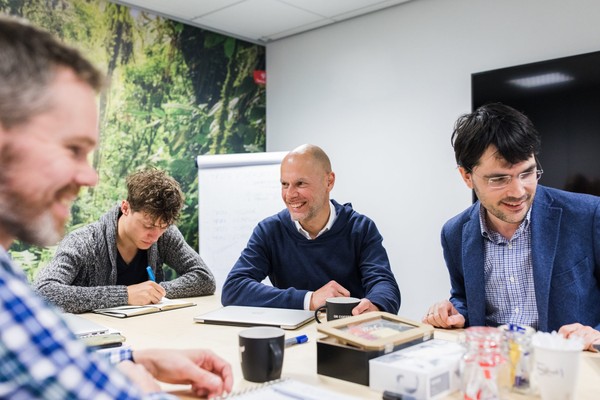cases >> SaXcell
WITH THEIR UNIQUE SAXCELL FIBER, THEY TURN THE CIRCULAR TEXTILE CHAIN UPSIDE DOWN.

WITH THEIR UNIQUE SAXCELL FIBER, THEY TURN THE CIRCULAR TEXTILE CHAIN UPSIDE DOWN.
How can the textile industry become more sustainable? An issue that Gerrit Bouwhuis, researcher and technologist, has been pondering for years. Gerrit: “The environmental impact of the textile industry is considerable. More and more products are being developed, and that also means an increasing mound of discarded textiles.” Together with colleague Ger Brinks, he felt responsible for changing this. They started testing and developed the recyclable fiber ‘SaXcell’. What can they do with it? And what does this mean for the textile industry?
A sustainable mission
In 2011, Gerrit and his colleagues decided to explore the options for recycling household cotton waste. “Cotton consists largely of H2O and CO2. Cotton requires a lot of agricultural lands, water, and fertilizer. This is not sustainable and in the long run even impossible,” says Gerrit. Ger adds: “We heard around us that optimal recycling of cotton was impossible because otherwise, someone would have done it a long time ago.” Yet this did not stop them from doing their own exploring.
The inception of SaXcell fiber
“One day, we managed to develop a type of thread from the cotton fibers of household cotton waste. This thread was in fact a new cellulose fiber, derived from old cotton. We invented it at Saxion, so we decided to call it the SaXcell,” says Gerrit. The team knew they had something special on their hands. With a grant from Saxion, they founded SaXcell B.V., and a larger team was able to further explore the fiber. From the start, the co-shareholders Henk Gooijer, Pramod Agrawal, and later Jens Oelerich contributed to this unique development.
“In 2015, together with a number of Dutch companies, we made the first dress from recycled material,” says Gerrit. We were also able to produce and process 100 kilos of SaXcell into 100 kilos of new yarns in leading spinning mills in Switzerland and Turkey. Gerrit: “Here we found out that the fiber could also be spun very finely, resulting in high-quality materials.”
A pilot with new shareholders
in the meantime, more parties were interested in SaXcell, including Wevotex and Sympany. With the results, the team went to Wevotex’s partners in Turkey, a country with advanced factories. “Here everyone was excited. They wanted to work with us, but we thought it was important to start a pilot in the Netherlands since the invention was made here,” says Gerrit. Unfortunately, they had little success in finding Dutch investors. After a year and a half of searching, they joined forces with Turkish shareholders after all in 2020. Gerrit: “They joined SaXcell B.V. and the pilot plant was set up in Goor. At the same time, an application was submitted to Regiodeal office to set up a circular textile infrastructure, including a textile lab at Saxion.”
Establishing the Textile Lab with Texplus
“Now we are conducting further research in the Textile Lab. At the same time, the pilot plant converts cotton waste into pulp on a larger scale for further processing into SaXcell. These SaXcell fibers form textile yarns for new products,” says Ger. This is where SaXcell and Saxion come together with Texplus. This includes Twente Milieu, Het Goed, De Beurs, Frankenhuis and Enschede Textile City as the six leaders in the field of textiles in the province of Overijssel. The foundation is supported by the regional deal. Gerrit: “Together we represent the whole chain. From textile collection to processing and creating a finished product for the market.”
Persevering and reflecting
“Sometimes it’s one step forward and two steps back,” Gerrit says. “As a researcher, you need to persevere, reflect and constantly watch your competition. We’ve had a lot of setbacks. People who didn’t believe in the product, investors who didn’t want to get involved. But at the end of the day, we got there, and we’ve started to scale up. We’re not there yet, but we’re doing all this to make the textile industry more circular, and I have faith in that.”
Are you a researcher and do you need help with putting your research to business? We can help. Take a look at what we can do for you.

"We are doing all this to make the textile industry more circular, and I have faith in that."
Gerrit Bouwhuis & Ger Brinks
Researchers SaXcellMore about
SaXcell
How can the textile industry become more sustainable? An issue that Gerrit Bouwhuis, researcher and technologist, has been pondering for years. Gerrit: “The environmental impact of the textile industry is considerable. More and more products are being developed, and that also means an increasing mound of discarded textiles.” Together with colleague Ger Brinks, he felt responsible for changing this. They started testing and developed the recyclable fiber ‘SaXcell’. What can they do with it? And what does this mean for the textile industry?






